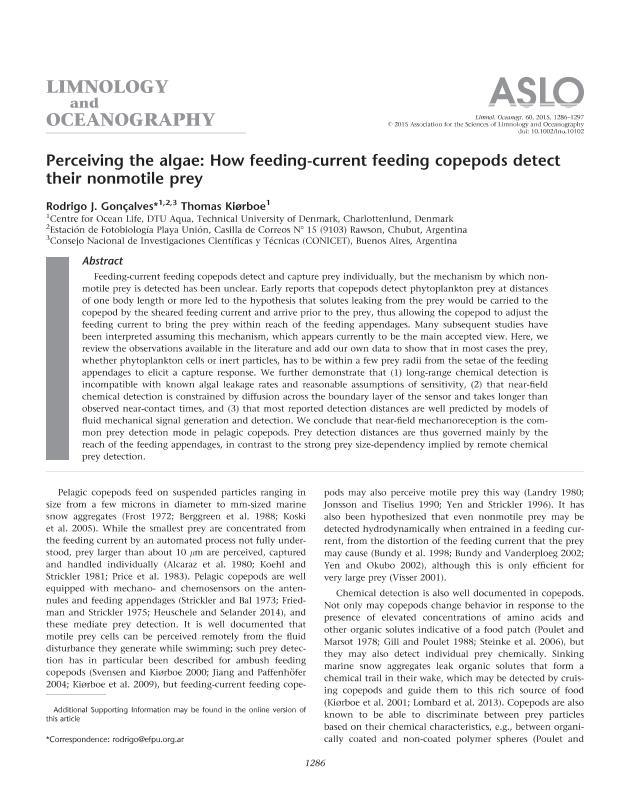Mostrar el registro sencillo del ítem
dc.contributor.author
Gonçalves, Rodrigo Javier

dc.contributor.author
Kiørboe, Thomas
dc.date.available
2020-03-05T17:41:48Z
dc.date.issued
2015-03
dc.identifier.citation
Gonçalves, Rodrigo Javier; Kiørboe, Thomas; Perceiving the algae: How feeding-current feeding copepods detect their nonmotile prey; American Society of Limnology and Oceanography; Limnology and Oceanography; 60; 4; 3-2015; 1286-1297
dc.identifier.issn
1939-5590
dc.identifier.uri
http://hdl.handle.net/11336/98844
dc.description.abstract
Feeding-current feeding copepods detect and capture prey individually, but the mechanism by which nonmotile prey is detected has been unclear. Early reports that copepods detect phytoplankton prey at distances of one body length or more led to the hypothesis that solutes leaking from the prey would be carried to the copepod by the sheared feeding current and arrive prior to the prey, thus allowing the copepod to adjust the feeding current to bring the prey within reach of the feeding appendages. Many subsequent studies have been interpreted assuming this mechanism, which appears currently to be the main accepted view. Here, we review the observations available in the literature and add our own data to show that in most cases the prey, whether phytoplankton cells or inert particles, has to be within a few prey radii from the setae of the feeding appendages to elicit a capture response. We further demonstrate that (1) long-range chemical detection is incompatible with known algal leakage rates and reasonable assumptions of sensitivity, (2) that near-field chemical detection is constrained by diffusion across the boundary layer of the sensor and takes longer than observed near-contact times, and (3) that most reported detection distances are well predicted by models of fluid mechanical signal generation and detection. We conclude that near-field mechanoreception is the common prey detection mode in pelagic copepods. Prey detection distances are thus governed mainly by the reach of the feeding appendages, in contrast to the strong prey size-dependency implied by remote chemical prey detection.
dc.format
application/pdf
dc.language.iso
eng
dc.publisher
American Society of Limnology and Oceanography

dc.rights
info:eu-repo/semantics/openAccess
dc.rights.uri
https://creativecommons.org/licenses/by-nc-sa/2.5/ar/
dc.subject
ZOOPLANKTON
dc.subject
PREY CAPTURE
dc.subject
FEEDING
dc.subject
PREY DETECTION
dc.subject.classification
Biología Marina, Limnología

dc.subject.classification
Ciencias Biológicas

dc.subject.classification
CIENCIAS NATURALES Y EXACTAS

dc.title
Perceiving the algae: How feeding-current feeding copepods detect their nonmotile prey
dc.type
info:eu-repo/semantics/article
dc.type
info:ar-repo/semantics/artículo
dc.type
info:eu-repo/semantics/publishedVersion
dc.date.updated
2020-03-03T15:08:42Z
dc.journal.volume
60
dc.journal.number
4
dc.journal.pagination
1286-1297
dc.journal.pais
Estados Unidos

dc.description.fil
Fil: Gonçalves, Rodrigo Javier. Technical University Of Denmark. National Institute For Aquatic Resources. Section Of Ocean Ecology And Climate; Dinamarca. Consejo Nacional de Investigaciones Científicas y Técnicas; Argentina. Fundación Playa Unión. Estación de Fotobiología Playa Unión; Argentina
dc.description.fil
Fil: Kiørboe, Thomas. Technical University Of Denmark. National Institute For Aquatic Resources. Section Of Ocean Ecology And Climate; Dinamarca
dc.journal.title
Limnology and Oceanography

dc.relation.alternativeid
info:eu-repo/semantics/altIdentifier/url/http://onlinelibrary.wiley.com/doi/10.1002/lno.10102/abstract
dc.relation.alternativeid
info:eu-repo/semantics/altIdentifier/doi/http://dx.doi.org/10.1002/lno.10102
Archivos asociados
